Family : Cistaceae

Text © Prof. Paolo Grossoni

English translation by Mario Beltramini
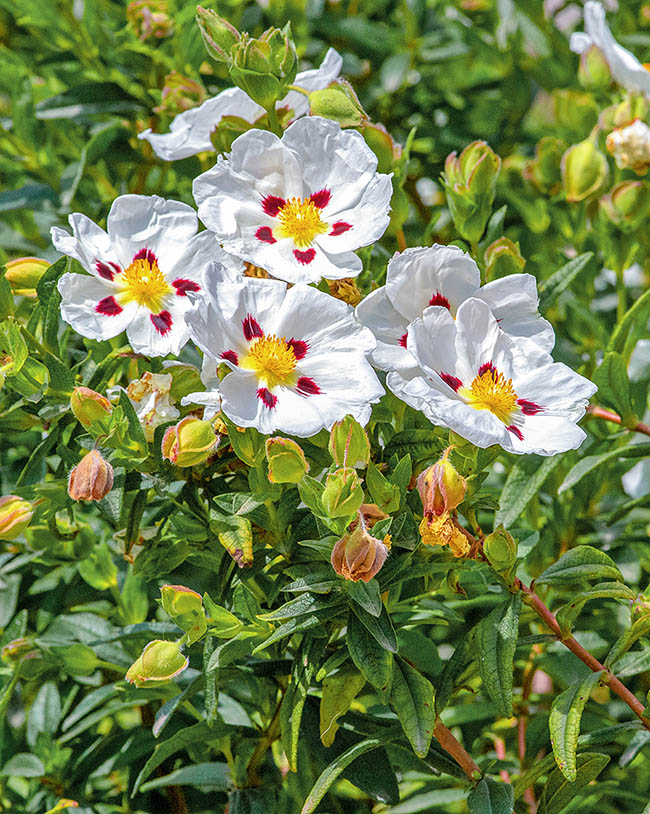
Cistus ladanifer is native to the south-western part of Mediterranean, from Algeria and Morocco to western Iberian Peninsula and Baleares. It is debated if it’s also native to Mediterranean south France where now is very frequent © Giuseppe Mazza
The specific epithet ‘ladanifer’ of this rock rose refers to the ladanum, or labdanum, exuded by the shrub and highly sought-after resin.
Commonly called in Italian cisto ladanifero, làdano, làdano del Portogallo; in French, ciste à gomme, ciste ladanifère, ciste porte-labdanum; in English, gum rockrose, laudanum, common gum cistus; in Spanish, jara pringosa, ládano; in Portuguese, esteva; and in German, Lack-Zistrose.
76% of the species of the genus Cistus L. (1753) are spontaneous plants of the Mediterranean zone, from northern Africa (but Egypt) to all southern Europe and from western Asia up to north-western Iran and to the desert of Negev.
The other species are Macaronesian endemisms of the Canary Islands and of Madeira.
As the riper fruit of the rock roses is a capsule opening longitudinally to disperse the seeds, Carl Linnaeus called the genus using the name already in use that, in turn, came from the Greek ‘κίστη’ (chíste) basket, capsule, box, used to indicate any vessel closed and empty inside.
Cistus is a critical genus that has been the subject of several revisions: presently it is formed by 33 species and by 34 hybrids (‘WFO World Flora Online’).
The new entries and the necessary movements, not only among the genera of the family but also with those of other families, have determined several synonyms.
The ‘WFO, 2024’ cites the following sybobyms: Halimium (Dunal) Spach, Ladanium Spach, Ladanum Raf., Ledonia Spach, Libanotis Raf., Rhodocistus Spach, Stegitris Raf., Stephanocarpus Spach and Strobon Raf.
The rock roses are small or medium sized evergreen shrubs and with leaves simple, opposite and decussate, coriaceous, sessile or petiolate, linear to ovate, 2-8(10) cm long; the margin is flat and smooth, or revolute or wavy. The young branches and the lower paginae of the leaves are pubescent or very pubescent and in some species they become white-greyish due to the density of the tomentum. They are more or less scented depending on the production of resins that is so much abundant in Cistus creticus, Cistus ladanifer and Cistus monspeliensis to have sticky twigs and leaves.
The flowers, solitary or in cymose inflorescences, have the corolla with 5 wrinkled-looking petals, white or pink or purple red; the calyx is formed by 3 or 5 sepals, in the second case the three outermost are bigger. In some species the base of the petal has a spot (nail) of yellow colour.
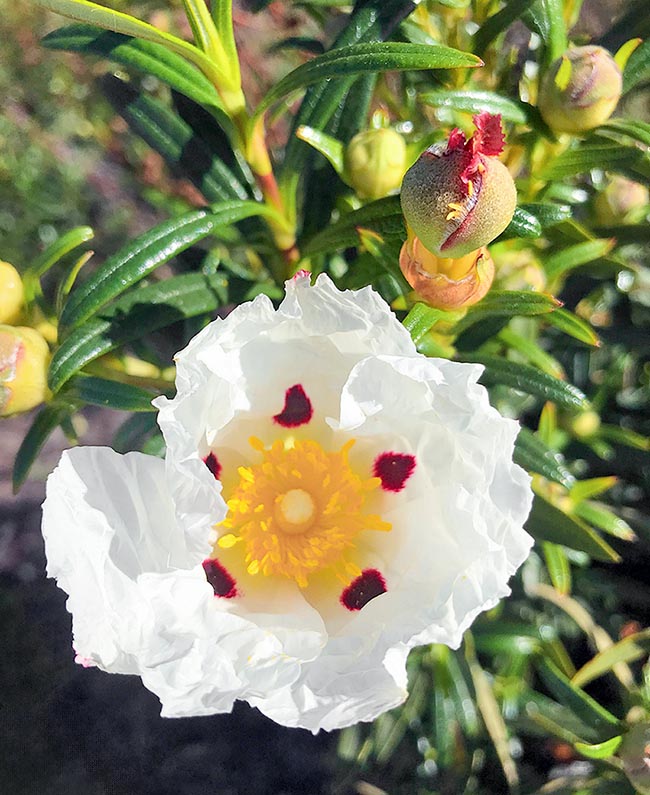
The Cistus ladanifer leaves are sessile, and the 5 petals have the typical crumpled appearance © sarahjavejones
The flowers are showy for their colour and size, (3)4-10 cm of diameter, but ephemeral: the white ones last one/two days whilst the red ones wither during the same day; however, as the anthesis lasts from late spring until late summer, the plant remains in bloom for a long time.
The flowers are hermaphroditic. The ovary, superior, is formed by one single pistil and by 5-6 carpels, an exception is Cistus ladanifer that has 6-12 carpels.
The androecium is formed by several yellow, very productive, stamens (50-200).
The pollination is always entomogamous and the flowers are visited by apids, syrphids and Coleoptera.
The fruit is a capsule with loculicidal dehiscence, formed by 5-6(12) chambers with many seeds that can remain for a long time.
The root system is robust and the roots, that can extend for 3-4 m penetrating into the ground for 100-150 cm, allow the colonization of arid soils, even loose or superficial, provided open and luminous.
For all species the chromosome number is 2n=18.
The rock roses are heliophilous, xerophilous and thermophilic. They fear cold winters (the most resistant rock rose is the Cistus laurifolius L.), require hot and dry summers and the optimum stands in the ‘belt’ of the evergreen Mediterranean forest.
Due to their needs in light and thanks to their tolerance to dry soils, they can occupy more or less degraded areas, such as garrigues and sand dunes, forming even coverings (rockrose shrubland).
Compared to many other plants, they are advantaged not only for the difficulties of those environments but also because they are allelopathic plants and, at the same time, also toxic for herbivorous, wild or domestic mammals.
Their diffusion is further favoured by the fire. The rock roses are typical pyrophyte, consequently the seedlings, being heliophilous and germinating immediately after a fire, can grow up without competition.
Moreover, the seminal integuments are hard and can easily protect the embryo from the high temperatures of the fire; due to the dehydration suffered, they then crack allowing the water and the air to reach the embryo.
It is obvious that, even in the absence of fires, over time environmental factors and saprophytes degrade the integuments making them permeable. Wanting to germinate seeds of rock rose, it is a good practice to pre-treat them by exposing them for about ten minutes at (80)-110 °C thus reproducing the effects of the passage of fire.
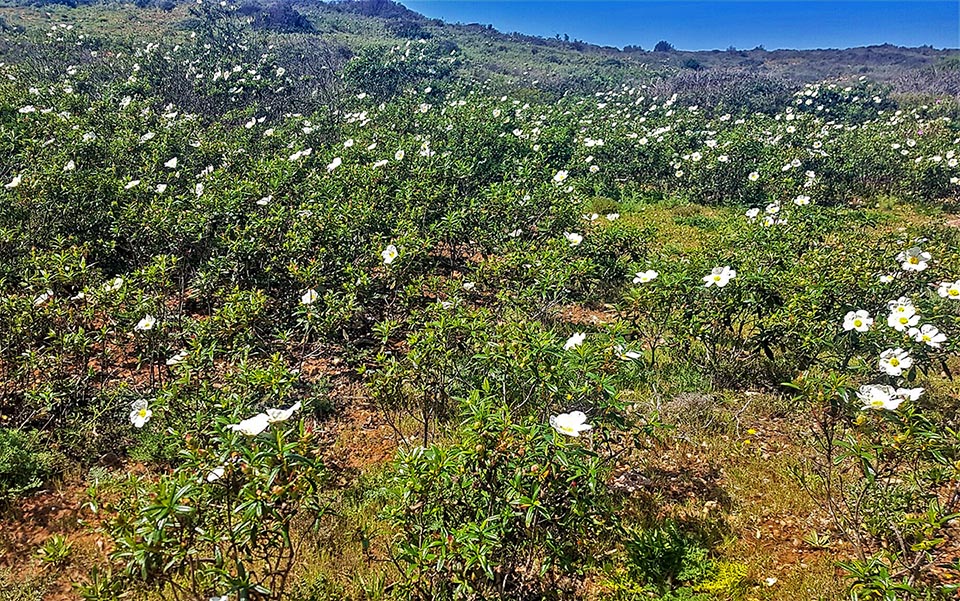
Typical ‘rock rose shrubland’ in South Portugal. Cistus laurifolius can exceed the height of 2 m with a width equal to half © Andrée Weigel
Provided cultivated in Mediterranean environments, due to their pioneerism and their rusticity the rock roses are utilized for the recolonization of burned areas, for the containment of loose grounds, for the production of honey and, with the suitable species, for the harvesting. of the labdanum, resin highly sought after in cosmetics and perfumery.
Obviously, the most sought after function is the ornamental one.
However, it is necessary to keep in mind that the hybrid forms are very diffused and it is not always possible to distinguish immediately from its parent species and, in this regard, Robert Page has pointed out that “Any cultivar with white petals and spotted is possible to be sold as Cistus ladanifer.”
Therefore the usefulness ceased of a subdivision of subgeneric ranks of this genus that, conversely, is still employed in the nursery practice distinguishing the taxa based in the colour of the petals: leukocystes or ‘WWPC’ (‘White or Whitish Pink Clade’), those with white flowers, whilst are called erythrocystes or ‘PPS’ (‘Purple Pink Clade’) those with pink-purple red flowers.
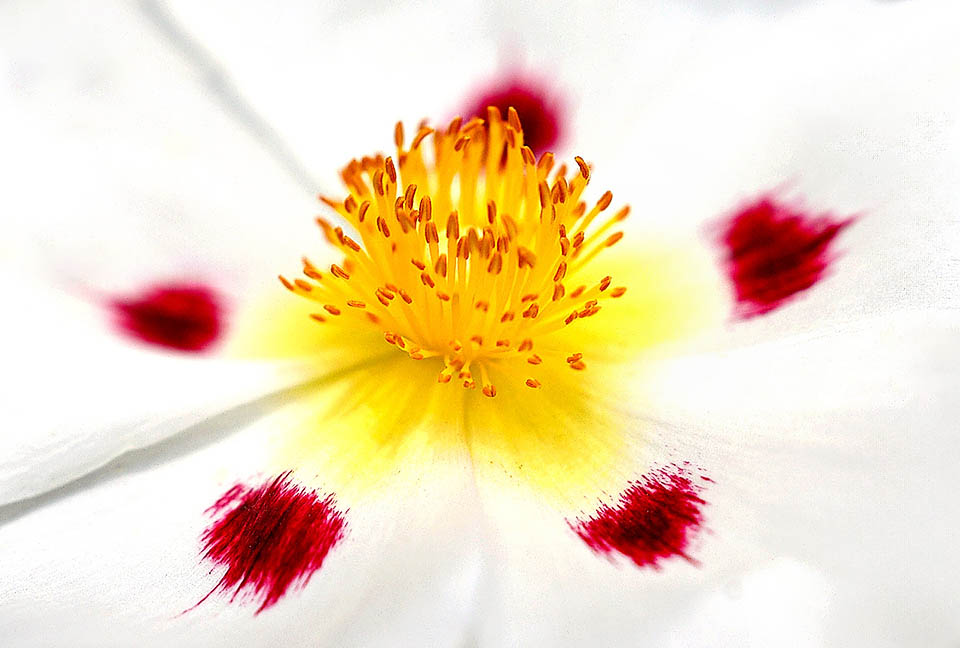
The solitary and scented flowers measure 7-10 cm. They are white with a yellow nail, usually overlaid by an intense red-brown spot frayed at the edge © Achim Mittler
Cistus ladanifer L. (1753) is an evergreen shrub with open and fragrant crown; fast growing, can reach 2(2,5) m of height and half the width. It has branchlets rapidly hairless and sticky for the resinous exudations that, with the age, from green become greyish.
The leaves are opposite and decussate, sessile or subsessile, lanceolate with revolute margin, 3-8 (19) cm long and up to 2 cm broad. They are discoloured: the upper pagina is dark green, glossy and glabrous; the lower, pale grey and tomentose also due to glandular hairs that secrete the resin, has 1-(3) veins of which the central one is prominent.
The flowers, particularly showy and scented, have a diameter of 7-10 cm; they are solitary and are carried by a short peduncle. The 5 petals, looking like crumpledmacchia’ paper, are white with a yellow nail usually overlaid by a bright stain, frayed at the margin, of intense red-brown colour.
Among the rock roses this spot is present only in this species and in the hybrids where it has transmitted. The pistil is surrounded by several (even more than 100) yellow-orange stamens, unequal in length but always longer than the pistil; the ovary is formed by 6-12 carpels. The calyx is formed by 3 oval sepals more or less long about ten millimetres, glabrous, tuberculate and initially pubescent.
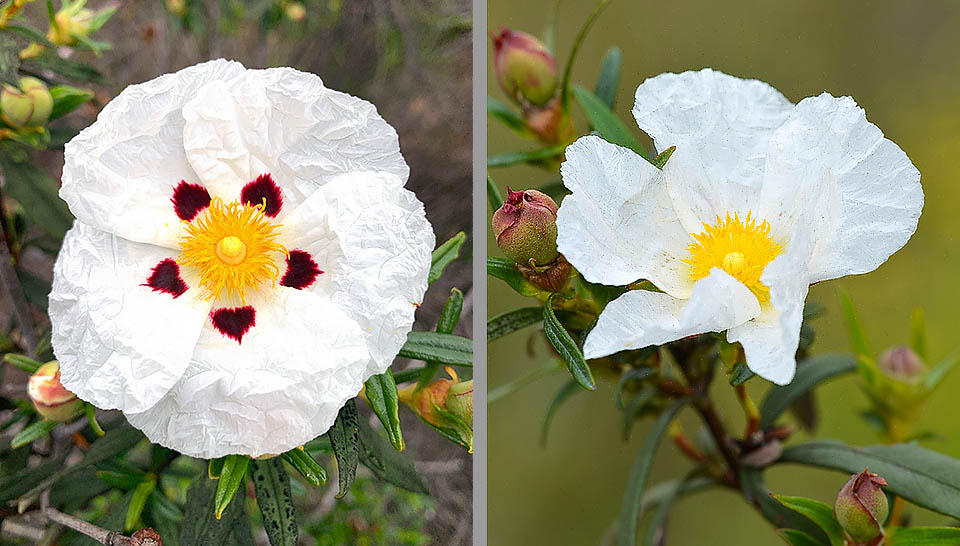
Pollination is entrusted to apids, syrphids and beetles. Left, the normal form © Eric Alan Isaacson. Right, the subspecies Cistus ladanifer sulcatus © Hans Hillewaert
The flowers are ephemeral and often the corolla is already withered towards the end of the first day (WWPC plant); the anthesis begins in late spring, but may last up to late summer with a profusion of flowers that attract numerous pollinators. The fruit is an ovoidal loculicidal capsule, pubescent, (7) 10-15 mm long with (6) 10 (12) chambers. It opens by the end of summer and during autumn and winter it frees up to une thousand of globose and brownish seeds having a diameter of 0,5-1 mm and a weight of 0,25-0,30 mg.
A single adult plant can produce even 150.000 seeds in one year. The seeds have hard and waterproof and airtight integuments that prevent germination that occurs only when the action of the climate events or the fire have not degraded them.
Like in all rock roses, the chromosome number of the species and of relevant varieties is 2n = 18. As well as by seed, it is possible to multiply this rock rose also agamically by means of cuttings of non-flowering branches cut in late spring or in late summer.
Cistus ladanifer is heliophilic, xerophilic and thermophilic; it is rather indifferent to the chemical nature of the soil and is considered as an allelopathic species because of the inhibitory effect, on the nearby plants, by its exudates, particularly rich in polyphenols and in diterpenes, (Chaves Lobón, N., et al., Plants, 2023, 12, 9.72).
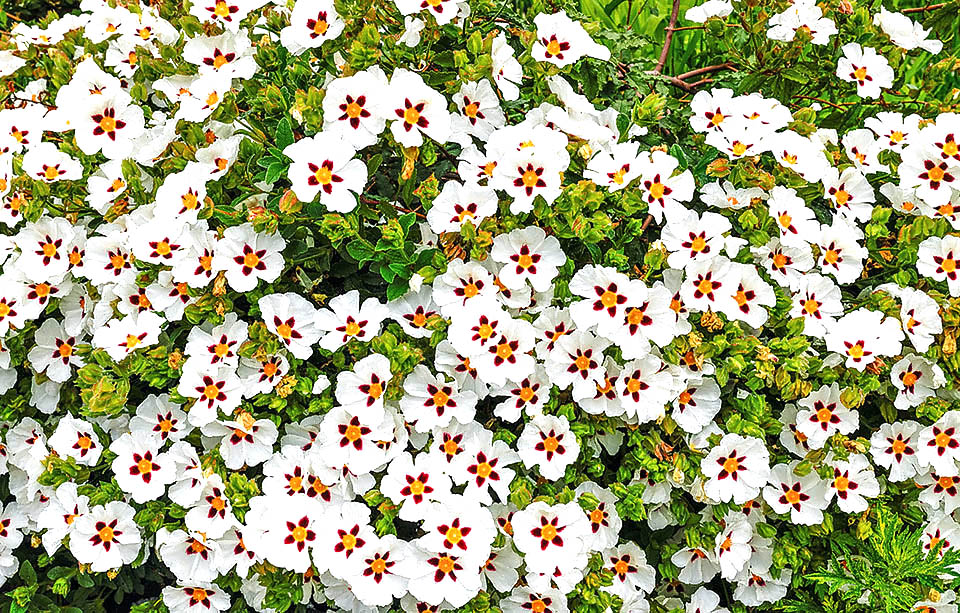
Cistus ladanifer gives the most required ladanum by perfume industry, but the ladanum is also an important ornamental plant for the Mediterranean garden © Tony Grover
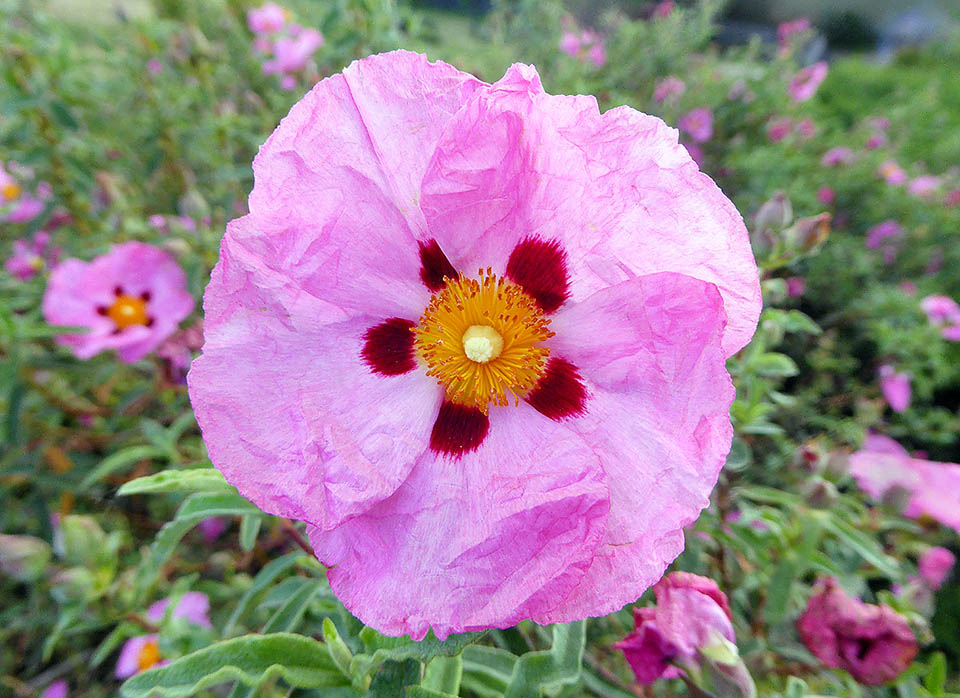
In fact several hybrids have been selected. One of the most diffused is Cistus x purpureus born in nature from Cistus ladanifer x Cistus creticus © Paco Garin
Among the rock roses, this species and the derived hybrids, are the most sought after to enliven and perfume the gardens. The ladanum (or labdanum) of this rock rose (from which the specific name (‘ladanifer’) is that most searched for by the perfume industry; it is a sticky brownish red resin, exudated by the leaves and the branchlets, employed due to its properties, its aromaticity and, especially, as fixative as it effectively bolsters the stability of the perfumes and has an effectiveness equal to the ambergris produced by the sperm whales.
The ladanum spreads a sweet and pleasant aroma and, thanks to its antioxidant activity particularly due to the flavonoids, was used for treating various pathologies.
This resin is not to be mistaken with the laudanum (or tincture of opium) that is instead an alcoholic solution of opium that, in addition to its dangerousness, has even completely different purposes.
This rock rose is frowned upon in agriculture as it may become a very competitive species. But it is also true that the presence of the rock rose improves the edaphic quality of the soil especially when this is poor in nutrients or polluted or if because previous fires have destroyed its organic layer.
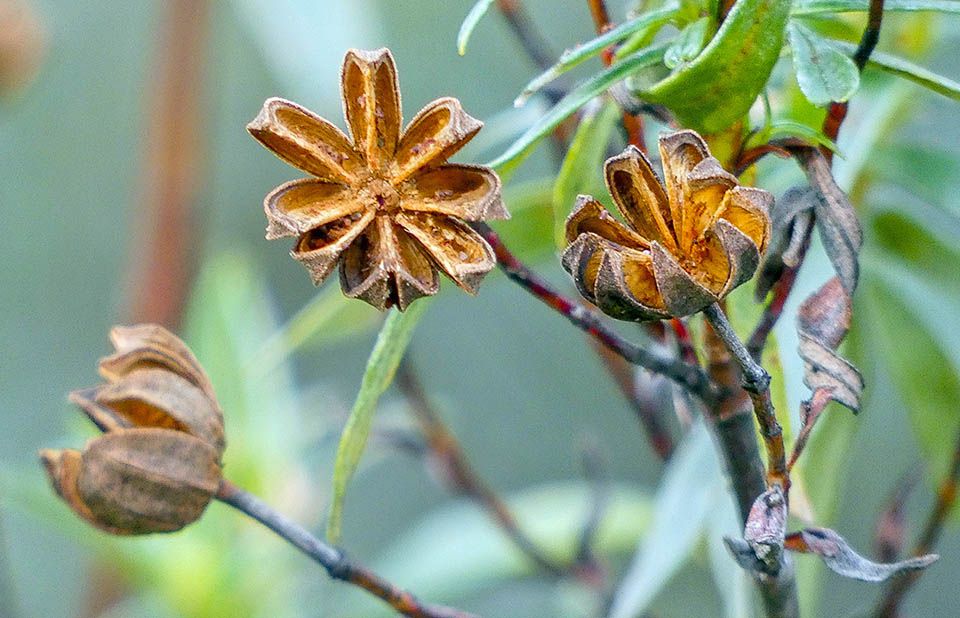
The Cistus ladanifer fruit is an ovoidal capsule, pubescent with loculicidal dehiscence divided even in 12 chambers © Antonio Rico García
As highlighted by the WFO map, Cistus ladanifer is spontaneous in the south-western sector of the Mediterranean, from Algeria and from Morocco to western Iberian Peninsula and to the Balearic Islands, whilst its spontaneity is quite doubtful in France, where, however, it is getting naturalized along the Mediterranean coasts. It has well acclimatized in the Gran Canaria, in Cyprus, in southern Australia, New Zealand and South Africa. In the latter the rock rose has been declared ‘invasive species’.
After WFO the species is divided in three subspecies:
– subsp. ladanifer – Morocco and Iberian Peninsula where it is particularly diffused in its western half. The capsule is subdivided in 9-10(12) chambers;
– subsp. mauritianus Pau & Sennen (= subsp. africanus Dens.); endemic to the coastal regions of Algeria and of Morocco; in Europe it is present exclusively in Spain in the province of Málaga. The leaves are elliptical but, unlike the other two subspecies, they are petiolate. The capsule is divided into 8-9 chambers.
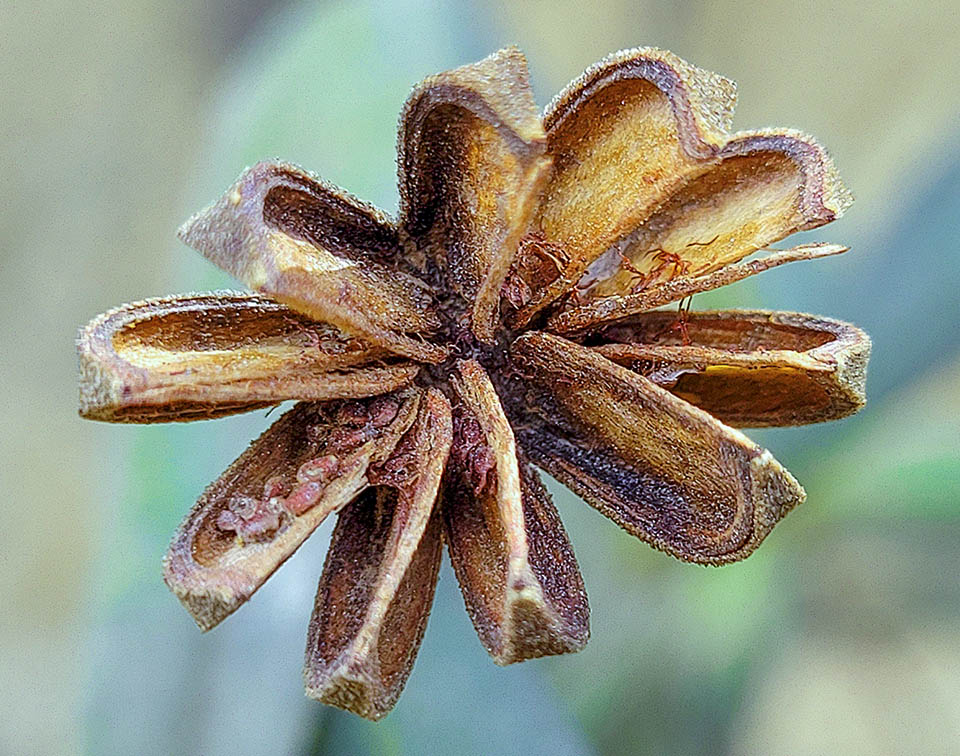
It opens towards summer end, or during autumn and winter, freeing up to one thousand globose and brownish seeds with 0,5-1 mm of diameter © Jordi Bassols Garcia
– subsp. sulcatus (Demoly) P.Monts.) – endemism of the SW extremity of the Algarve (Portugal). Compared to the other two subspecies, the plant is smaller and, usually, has very sticky sessile leaves, elliptical, smaller (42 x 16 mm) and with prominent veins. The flowers are smaller (5 cm) and totally white; the capsule is subdivided into 8-9 chambers. Its synonym still in use is palhinae Ingram.
Thanks to the beauty of its flowering, this species has become an important ornamental plant for the Mediterranean garden. For this purpose are also used hybrids obtained by the random or anthropic crossing of the ladaniferus rock rose with other species of the same genus.
Some of these hybrids and of these varieties, Cistus ladanifer subsp. sulcatus f. bicolor, Cistus ladanifer ‘Bashful’, Cistus ladanifer ‘Blanche’, Cistus × cyprius ‘Troubadour’, Cistus × aguilarii (Cistus ladanifer × Cistus populifolius), Cistus × purpureus (Cistus ladanifer × Cistus creticus), have encountered a good success also for the few cultivation needs. In the previously mentioned tab (WFO (2024) are reported 35 hybrids and the synonyms, due to the different taxonomic interpretations proposed in the past, are 35 that are divided for the subsp. ladanifer (23 names), for the subsp. mauritianus (8) and 4 for the subsp. sulcatus.
→ To appreciate the biodiversity within CISTACEAE family please click here.
